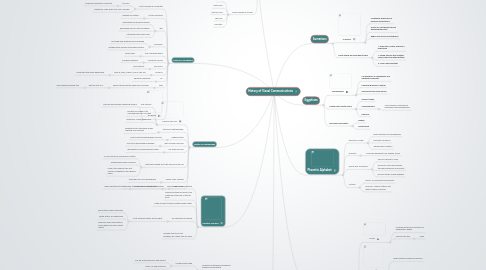
1. 50,000 years ago Cave Paintings
1.1. Lascaux
1.1.1. dates
1.1.2. cave discovered in france
1.2. 3 reasons why they were created
1.2.1. story telling
1.2.2. religious reasons
1.2.3. instruction
1.3. definition
1.3.1. a prehistoric picture on the inside of caves
1.4. Typical themes
1.4.1. Large animals
1.4.2. tracing of hands
1.4.3. abstract patterns
1.5. paint created by mixing
1.5.1. water
1.5.2. plant juice
1.5.3. animal blood
1.5.4. charcoal
1.5.5. hematite
2. Gutenberg Press
2.1. Johannes Gutenberg introduced modern book printing
2.1.1. created metal type
2.1.1.1. Can be produced easily and quickly
2.1.1.2. Metal, Tin and antimony
2.1.2. Created oil-based ink
2.2. Printing press
2.2.1. ink was rolled over the raised surface of movable hand-set letters
2.2.2. Bible was first book to be printed
2.3. developed from screm-type for pressing grapes
2.4. Got John Fust to give him an investment
2.4.1. Johannes couldn't pay him back so John got his press
2.4.2. Took credit for the invention along with his helper, Schoeffer
2.5. Still use these today
2.5.1. Relief printing, intaglio, porous, and lithography
3. Linotype Machine
3.1. Invented by James Clephane
3.1.1. Tested shole's typewritter
3.1.1.1. made adjustments to it
3.2. Named linotype because it can create an entire line of text at once
3.3. Made it easier to type multiple pages faster
3.4. 90 character key board
3.4.1. Most frequent letters on the right
3.4.1.1. Black letters were lowercase
3.4.1.2. White letters are uppercase
3.4.1.3. Blue keys were punctuation, small digits and small capital letters
3.5. Allowed type to be set mechanically rather than by hand
4. History of Photography
4.1. Camera Obscura
4.1.1. first camera
4.1.2. projects an image of its surroundings onto a screen
4.1.3. started as a large, dark room
4.2. the word "photography"
4.2.1. originated from the greek words "lighting" and "writing"
4.3. Daguerrotype
4.3.1. first practical photographic process
4.4. wet collodion process
4.4.1. Had to be developed imediately
4.5. dry plate process
4.5.1. used gelatin for photographic plates
4.6. Eastman created film that anyone could use
4.6.1. all you had to do was press a button
4.6.2. established Kodak Company
4.6.3. made "the brownie" the first camera marketed to the general publc
4.7. James Clerk Maxwell
4.7.1. took the first color photograph
4.8. Edwin Land
4.8.1. patented the invention of instant photography
5. History of Computers
5.1. First commercial computer
5.1.1. UNIVAC
5.1.1.1. Universal Automatic Computer
5.1.2. created by John Ekert and John Mauchly
5.2. Mark computers
5.2.1. created for military
5.3. IBM
5.3.1. international business machine
5.3.2. developed IBM701 EBM computer
5.3.3. introduced the floppy disk
5.4. FORTRAN
5.4.1. first high level programming language
5.4.2. mathematical formula translating system
5.5. first computer game
5.5.1. space wars
5.6. computer mouse
5.6.1. Douglas Englebert
5.7. ARPANET
5.7.1. first internet
5.8. mid 90's
5.8.1. Mark 8, Altair, Apple 1 and 2-TRS-80
5.8.1.1. computers that were developed
5.9. PC
5.9.1. personal computer
5.10. 1983
5.10.1. apple introduced the apple lisa computer
5.10.1.1. had the first GUI
5.10.1.1.1. xerox helped develop this
5.11. bill gates
5.11.1. introduced windows operating system
6. Sumerians
6.1. Cuniform
6.1.1. Created to keep track of business transactions
6.1.2. Wrote on clay tablets using a wedge shaped tool
6.1.3. Began as a series of pictograms
6.2. Three things we know about them
6.2.1. 1. Theocratic culture ruled by a priest king
6.2.2. 2. skilled artisans that created vases, bowls and other pottery
6.2.3. 3. Music was important
7. Egyptians
7.1. Hieroglyphics
7.1.1. Combination of logographic and alphabetic elements
7.1.2. Expressing words in writing
7.1.3. Derived by two Greek words
7.2. Created the rosetta stone
7.2.1. Ancient Greek
7.2.2. Hiegroglyphics
7.2.2.1. Jean Francois Champollion deciphered the hieroglyphics
7.2.3. Demonic
7.3. Recorded information
7.3.1. religion
7.3.2. Government
8. Phonetic Alphabet
8.1. theories of origin
8.1.1. direct variation of heiroglyphics
8.1.2. ties with cuneiform
8.1.3. independent creation
8.2. principle
8.2.1. One sign represents one spoken sound
8.3. Why it was sucsessful
8.3.1. easy for people to learn
8.3.2. spread to Africa and Europe through Phoenician merchants
8.3.3. influenced the Greek alphabet
8.4. 2 styles
8.4.1. formal- for important documents
8.4.2. informal- used for letters and routine types of writing
9. Codex/Illuminated Manuscript
9.1. codex
9.1.1. covered and bound collection of handwritten pages
9.1.2. church uses this
9.1.2.1. bible
9.2. scroll
9.2.1. long continuous piece of papyrus
9.3. advantages of codex
9.3.1. allowed for random access
9.3.2. compactness
9.3.3. structure
9.3.4. ease of reference
9.4. parchment paper replaces papyrus
9.4.1. made of animal skins
9.4.2. more durable than parchment
9.5. Illuminated manuscript
9.5.1. elaborated writings
9.5.2. reserved for religious texts
